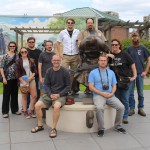
On the weekend before orientation, the Industrial Archaeology Program (SS) made a graduate-study tour to Milwaukee. Five Social Sciences faculty and five graduate students (SS and HU, both MS and PhD) investigated industrial production, adaptation to industrial decline and how urban patterns have been affected by industry, both historically and today.
The five-day trip, partly underwritten by the Chipstone Foundation of Milwaukee, included factory process tours, museum visits, and a day at Chipstone discovering explanatory and interpretive strategies for material culture, primarily using the history of the ceramics industry as the focus for the day.
Visits included the Kohler Company, which produces ceramic and cast iron bathroom fittings; Caterpillar Global Mining (formerly Bucyrus-Erie), which builds some of the largest earth-moving machinery on the planet; Harley-Davidson Powertrain Operations, where we saw engines and transmissions being assembled on a state-of-the-art assembly line; La Lune designer rustic furniture company, where small-batch artisanal woodworking is still practiced; and the Falk Foundry (Rexnord Industries) in Milwaukee, which has sadly been decommissioned in the last six months, but which offered a glimpse of active deindustrialization.
Museum visits included the Hamilton Wood Type Museum in Two Rivers (WI), the Grohmann Museum at the Milwaukee School of Engineering, which has an extensive collection of artwork depicting industrial work, and the Iron Mountain (MI) Pumping Museum. The final stop of the whirlwind tour was the Wisconsin Historical Society’s Herrling Sawmill in Greenbush (WI), a reconstructed 1850s vertical sash sawmill. The historically accurate sawmill has been reconstructed on the basis of archaeology done by Michigan Tech’s Industrial Archaeology Program in the 1990s. Sadly, the day we visited the saw blade was misaligned and a main bolt had sheared, so it was not running, but it was wonderful to see the final result of our archaeology of 20 years ago.
Taken from Tech Today.